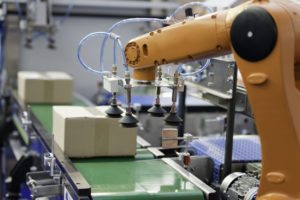3 Trends in Robotic Material Handling in the Industrial Sector
 Robotic Material Handling (MH) has emerged as one of the most effective and most popular industrial robotic applications. Together with robotic welding, they make up 70% of the global market for industrial robots.
Robotic Material Handling (MH) has emerged as one of the most effective and most popular industrial robotic applications. Together with robotic welding, they make up 70% of the global market for industrial robots.
The market for MH robots is expected to grow at a 5% compound annual growth rate (CAGR) between 2016 and 2024. The outlook is strong for robotic material handling. There are constantly new robots and new technology introduced, continuously advancing robotic MH capabilities.
So what does the future hold for robotic material handling applications?
3 Robotic Material Handling Trends
There are a few trends to keep an eye one that may have a huge impact on manufacturing.
1. Robotic Connectivity
The Industrial Internet of Things (IIoT) is primed to impact the industrial sector in many ways, and robotic MH applications are no different. Robots that perform MH functions are strategically placed to collect information on manufacturing productivity, efficiency and speed. This data can be used to fine tune production and material handling.
2. Total Process Simulation
Most robotic integration projects, including MH systems, involve some form of robot simulation before the system is built and installed. However, with more data collected from higher-connectivity MH robots, the information can be used to create comprehensive process simulations. This can enable transformative changes to MH robots, possibly allowing for less linear production, but can also help create efficiencies in overall production processes.
3. Process Flexibility
As things like IIoT, advanced simulations, new robotic technologies and vision systems continue advancing robot MH capabilities, their responsibilities may begin to change. Production may not be rooted in one place – MH systems may become more mobile and involve detailed safety features to work more collaboratively with humans outside of a workcell. Advances in end of arm tooling (EOAT) will also contribute to the widening capabilities of robotic MH systems, allowing for flexibility in functions without reprogramming.
Robotic material handling systems are already widely popular in the industrial sector for the major productivity benefits they provide. As the technology advances, keep on eye on the three trends above as MH systems play an even more important part of production.
To learn more about robotic material handling systems and their applications, read our robotic material handling case studies to see how manufacturers have benefited greatly from these systems.
Posted in Robotic Material Handling
Very interesting! My family owns a manufacturing company and we are looking to improve/innovate our production lines. I find these robotic arms a good solution for efficiency and increased productivity. Thanks for the great read!
That is a really good post.